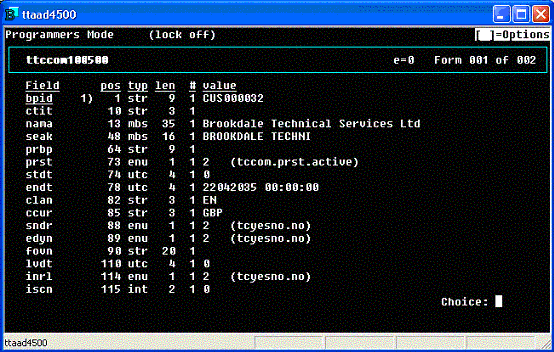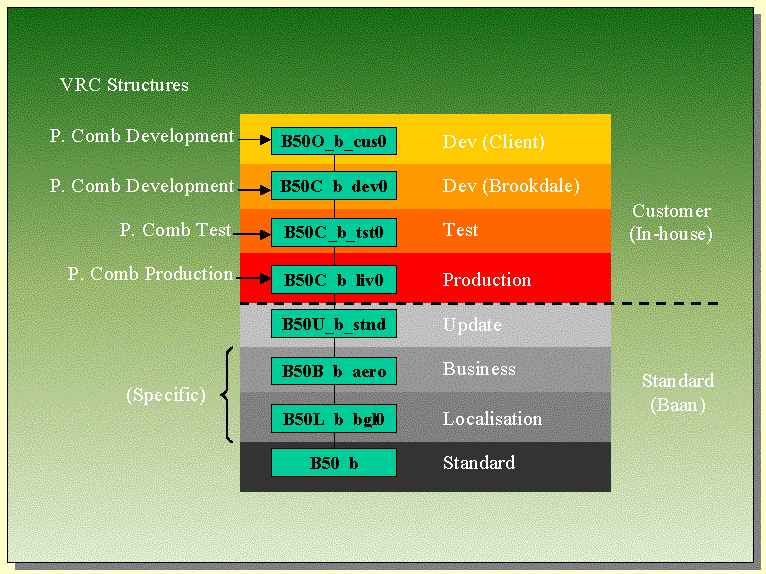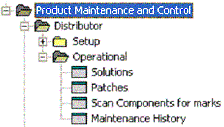 "Though Baan's functionality is comprehensive and covers all generic business areas, organisations often require specifically-designed and built sessions to enable either replication of the function of legacy systems or replacement and improvement of current methods. New development can also encompass brand new functionality and can be integrated seemlessly into Baan."
"Though Baan's functionality is comprehensive and covers all generic business areas, organisations often require specifically-designed and built sessions to enable either replication of the function of legacy systems or replacement and improvement of current methods. New development can also encompass brand new functionality and can be integrated seemlessly into Baan."
By developing new sessions in Baan, the full flexibility of the product can be realised, enabling you to maximise your
productivity and simplify your departments' working methods. Unique, business-specific solutions can be developed
and tailored to meet your requirements and offer you great advantages in controlling and running your business.
Some examples:
 Create 2-way interfaces between Baan and your dedicated systems
Create 2-way interfaces between Baan and your dedicated systems
 Build new tables and sessions to store and process specialised data
Build new tables and sessions to store and process specialised data
 Create new processing sessions to merge functionality and simplify tasks
Create new processing sessions to merge functionality and simplify tasks
 Produce customer-specific documentation
Produce customer-specific documentation
 Construct tailored forms and menu structures to simplify operation
Construct tailored forms and menu structures to simplify operation
 Generate internal control procedures
Generate internal control procedures
Specifications -
Environment -
Product Maintenance and Control -
Programming
 Preparation
Preparation
Before commencing a development project, it is necessary to have an appropriate control system in place.
Having many years' experience of large development projects, Brookdale is able to employ a strict, proven change control
procedure that will help you to manage your development work and ensure that appropriate approval and control
processes are adhered to. Full details are available on request.
All development work is also undertaken to a recognised standards and procedures document, that encompasses full
project administration and Product Maintenance and Control (PMC) where appropriate. See the
Programming section for more details.
 Specifications
(Functional, Technical)
Specifications
(Functional, Technical)
Functional
The development process will begin with identifying a requirement for functionality that will replace that of a legacy
system, act as an alternative to standard Baan or introduce a new concept.
In any event, a functional specification
will need to be drawn up, detailing requirements such as data sources, data input, form and report layouts and the
desired outcome. An impact assessment is also useful at this stage in order to evaluate the effect of any proposal
on other systems or applications.

Technical
Usually, this finalised and agreed document will be followed by a technical specification, giving data selection and processing details, along with any other technical data that will be relevant
or useful in tracing development work.
Shown below is a short extract of the type of detail contained in technical specifications.

Graphical representations of intended developments will be shown, along with an annotated analysis of the 4GL
code to be used. Data sources, data type & format, new component names and report specifications will also be detailed if included in the
development. Any new tables must be specified showing field names and data types, indices and permitted values. Entity
relationship diagrams will also be included where appropriate.
General table display session showing table data field names, data type and value:

Technical specifications are often useful when re-visiting or modifying developments at a later stage.
 Environment
Environment
Prior to commencing development, it will be necessary to ensure that a suitable development environment exists.
This environment must consist of at least 1 development VRC and 1 test VRC. (If you do not have any of this set up,
Brookdale can create and configure it for you). The configuration of a Product Maintenance
& Control (PMC)
structure will also be verified - if applicable to your installation - to ensure efficient, robust solution
distribution and maintenance.
(It is also often advisable to utilise a separate development server, though
Brookdale will discuss specific requirements with your technical staff.)
An example of a simple, effective development environment is shown below (Baan Vb):
 In the figure above, the VRCs below the dotted line represent possible levels of standard software, those above
represent an operational VRC for your live companies, a testing area for submitted developments and two development
areas, one for a customisation partner and one for in-house development.
In the figure above, the VRCs below the dotted line represent possible levels of standard software, those above
represent an operational VRC for your live companies, a testing area for submitted developments and two development
areas, one for a customisation partner and one for in-house development.
 Product Maintenance and Control
Product Maintenance and Control
 Product Maintenance and Control was introduced with Baan IV and is an excellent tool for managing solution
installation (and removal if necessary). It replaces the previous method of software installation which was
performed using manual internal import & export of dumps.
Product Maintenance and Control was introduced with Baan IV and is an excellent tool for managing solution
installation (and removal if necessary). It replaces the previous method of software installation which was
performed using manual internal import & export of dumps.
Its use does not only apply to standard solutions received from Baan,
as PMC can be configured to allow in-house development or customisations to be controlled in the same way. All
development work undertaken by Brookdale will be managed using PMC, where present.
Once a suitable structure is in place, all versions of all software components are tracked and solutions can easily be
installed, tested and removed for modification if necessary. This is a one-time set up:

Baan's PMC dependency functionality also controls the installation of subsequent solutions by ensuring that all
pre-requisites are in place. Standard Baan sessions exist that enable excellent visibility of solutions' components,
dependencies, status and maintenance history. All new development solutions can therefore be easily viewed and monitored.
 Programming Guidelines
Programming Guidelines
 By making the decision to undertake the development of new Baan software, you are extending and personalising the
function of your Baan system to exactly fit your requirements.
By making the decision to undertake the development of new Baan software, you are extending and personalising the
function of your Baan system to exactly fit your requirements.
The flexibility exists to create new sessions, forms,
reports, UI and DAL scripts, libraries, functions, menus, tables, messages, questions and labels. These new components
can be integrated into Baan's existing packages and modules by the use of standard naming conventions or it is
possible to create new packages and to develop a completely new area of your business.
Since each development
project is unique and has specific goals, it is suggested that you contact Brookdale to arrange an informal meeting
to discuss your business needs.
All new software components are created in accordance with Baan's own development procedures, including the use of naming conventions. Program scripts are clearly marked with development specification references and change markers.
Project administration is strictly adhered to in order to enable all development work to be tracked and referenced.
Having undertaken large developments over a number of years, developing new solutions is one of Brookdale's
particular areas of expertise.
For details of the options of types of sessions to which development can be applied, see the
customisation page.
Note: In order for any new development work to be performed on your server, a development licence will
be required - this is available from the Baan company, though your organisation might already have one.
Development
Development
 "Though Baan's functionality is comprehensive and covers all generic business areas, organisations often require specifically-designed and built sessions to enable either replication of the function of legacy systems or replacement and improvement of current methods. New development can also encompass brand new functionality and can be integrated seemlessly into Baan."
"Though Baan's functionality is comprehensive and covers all generic business areas, organisations often require specifically-designed and built sessions to enable either replication of the function of legacy systems or replacement and improvement of current methods. New development can also encompass brand new functionality and can be integrated seemlessly into Baan." Create 2-way interfaces between Baan and your dedicated systems
Create 2-way interfaces between Baan and your dedicated systems Build new tables and sessions to store and process specialised data
Build new tables and sessions to store and process specialised data Create new processing sessions to merge functionality and simplify tasks
Create new processing sessions to merge functionality and simplify tasks Produce customer-specific documentation
Produce customer-specific documentation Construct tailored forms and menu structures to simplify operation
Construct tailored forms and menu structures to simplify operation Generate internal control procedures
Generate internal control procedures Preparation
Preparation Specifications
(Functional, Technical)
Specifications
(Functional, Technical)



 Environment
Environment
 Product Maintenance and Control
Product Maintenance and Control Product Maintenance and Control was introduced with Baan IV and is an excellent tool for managing solution
installation (and removal if necessary). It replaces the previous method of software installation which was
performed using manual internal import & export of dumps.
Product Maintenance and Control was introduced with Baan IV and is an excellent tool for managing solution
installation (and removal if necessary). It replaces the previous method of software installation which was
performed using manual internal import & export of dumps.
 Programming Guidelines
Programming Guidelines By making the decision to undertake the development of new Baan software, you are extending and personalising the
function of your Baan system to exactly fit your requirements.
By making the decision to undertake the development of new Baan software, you are extending and personalising the
function of your Baan system to exactly fit your requirements.